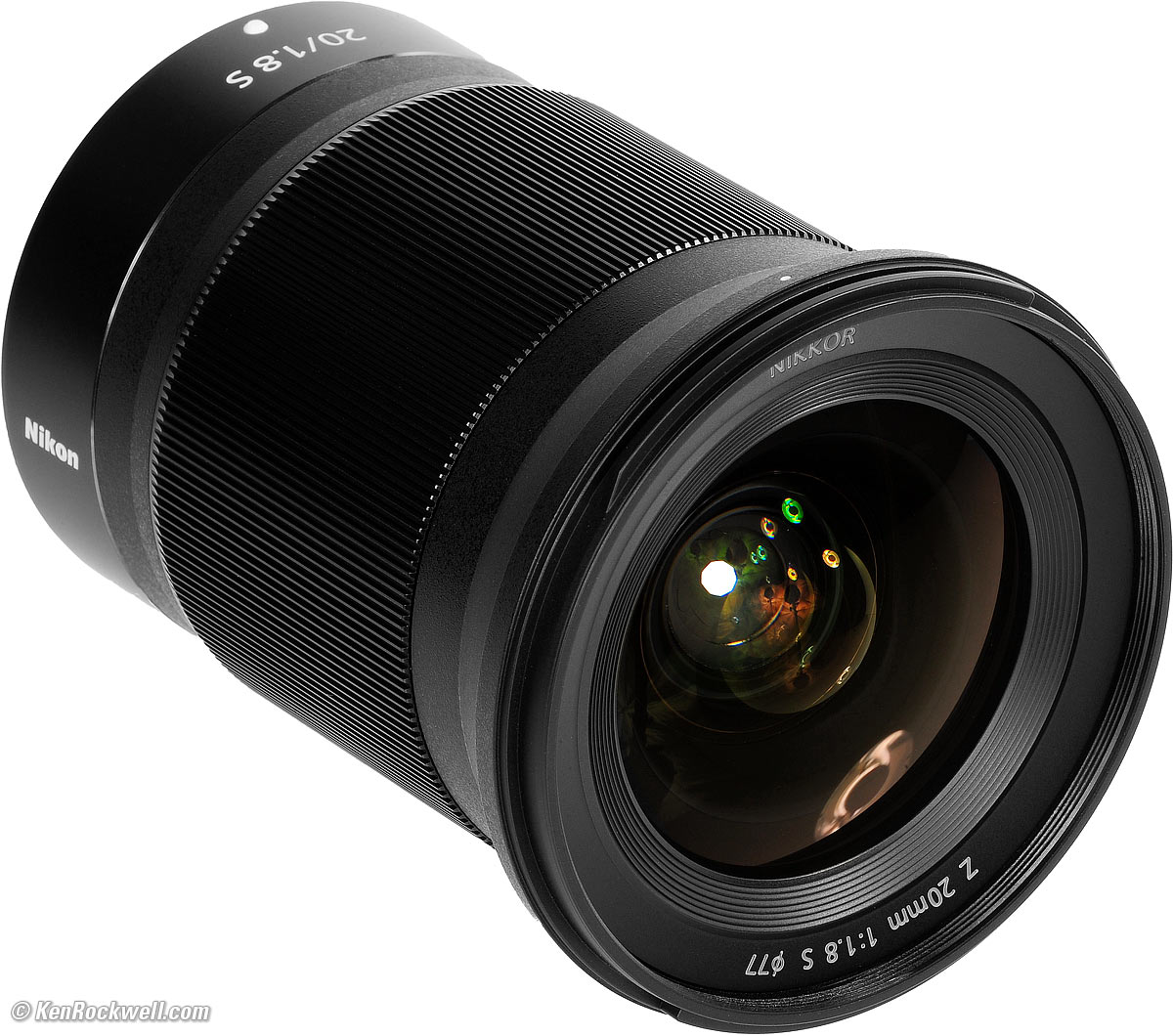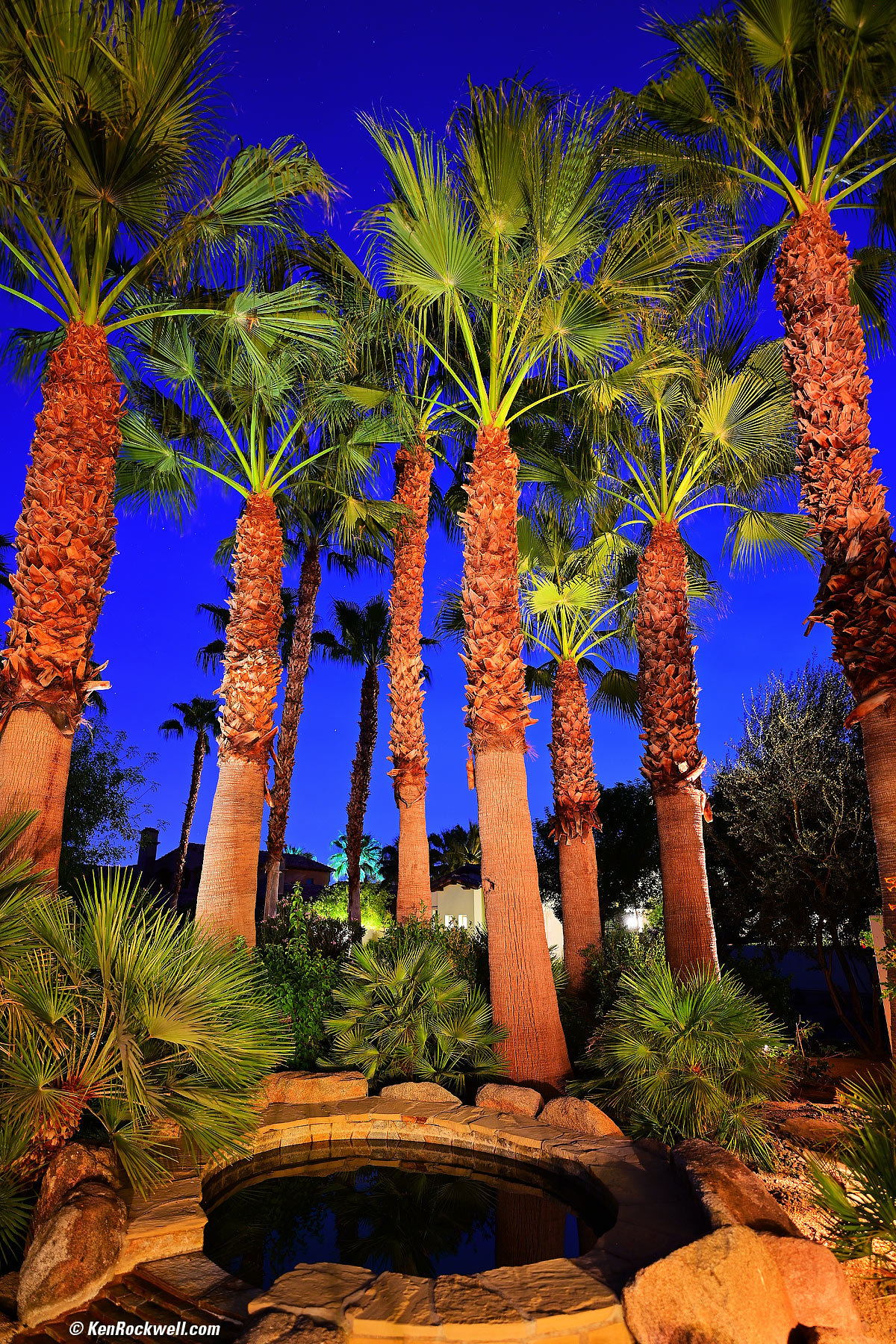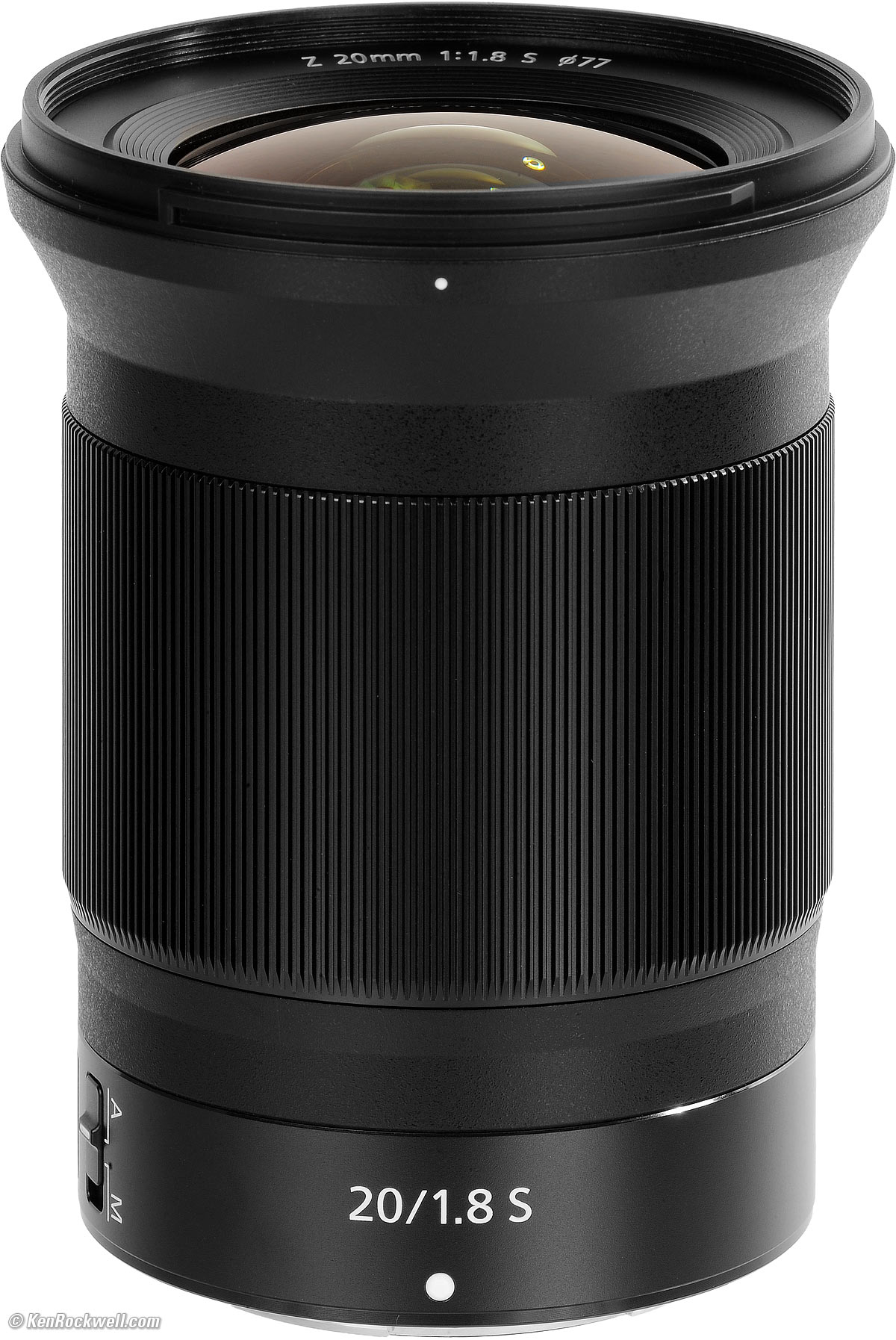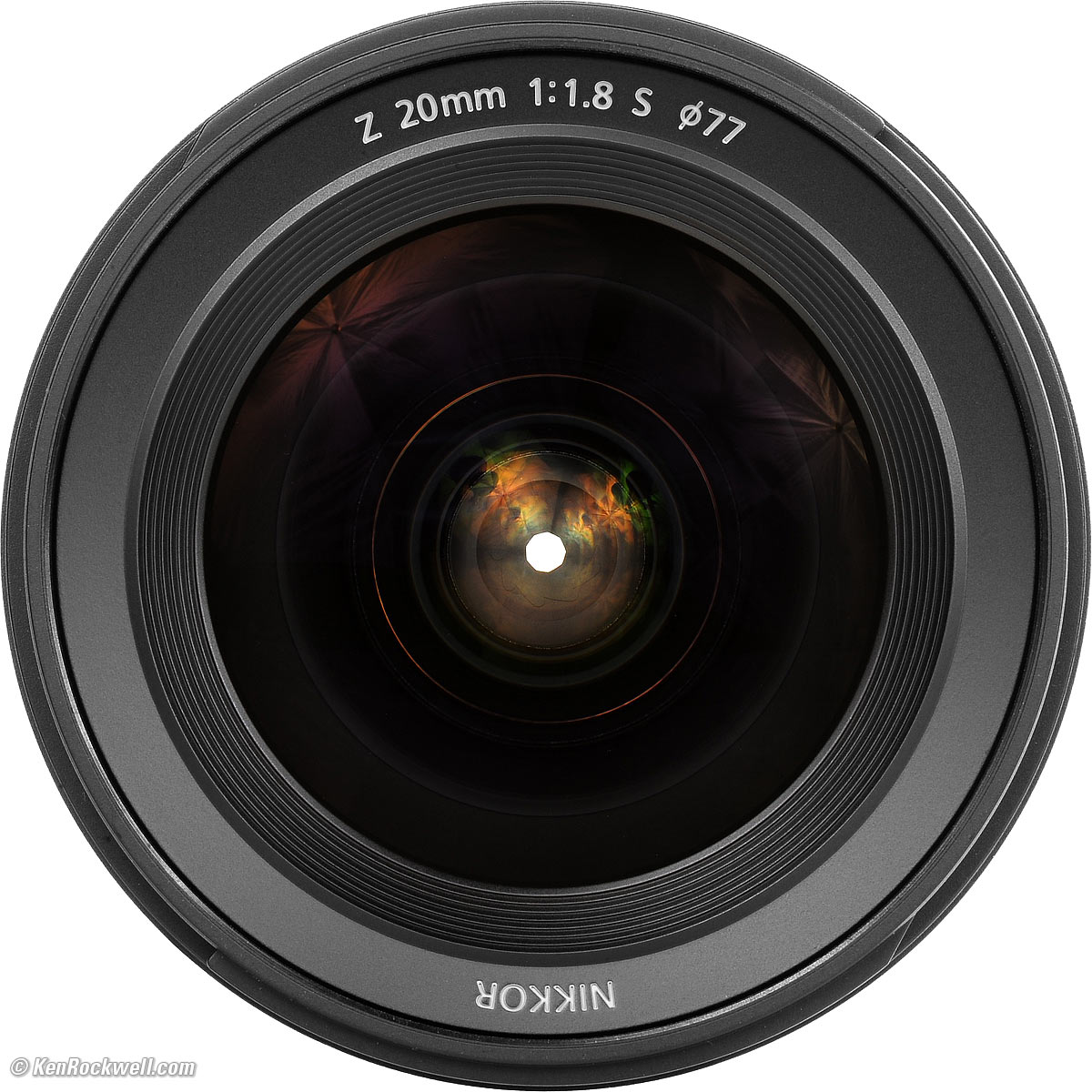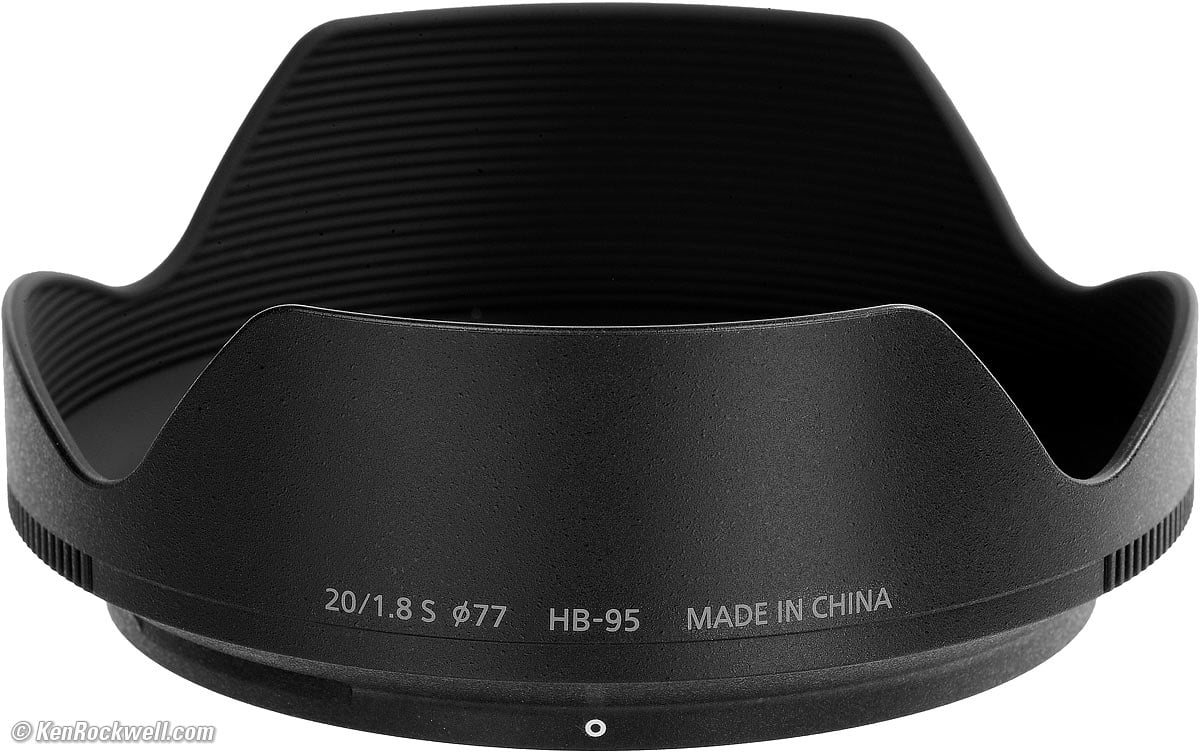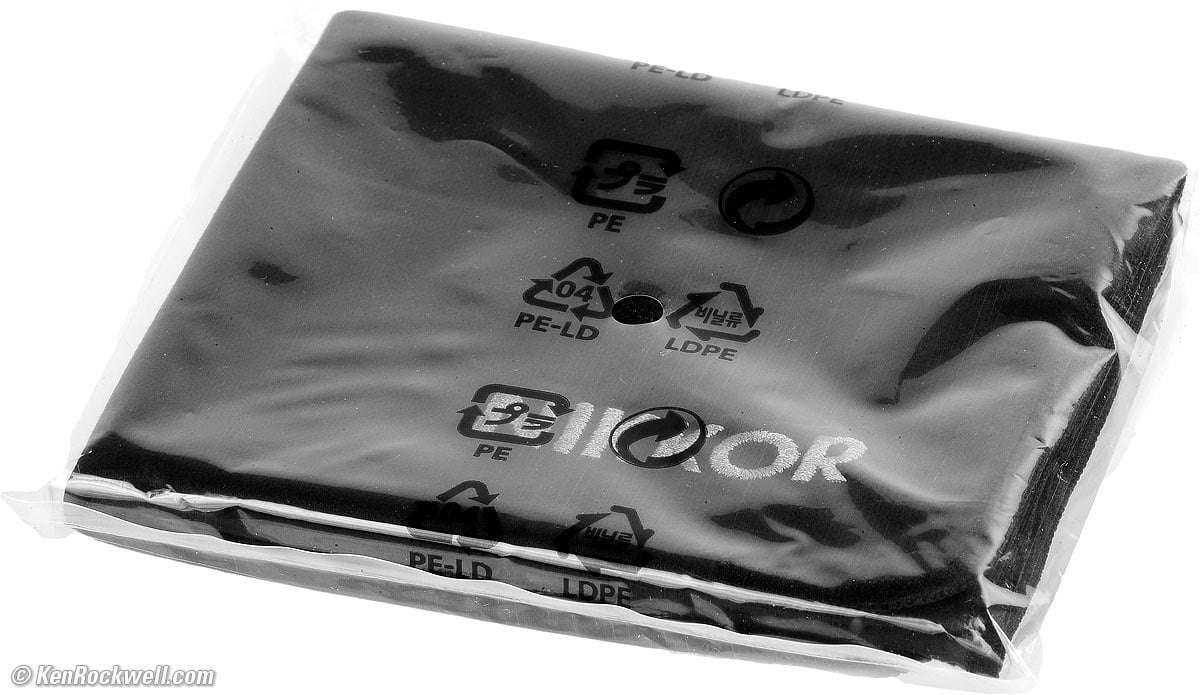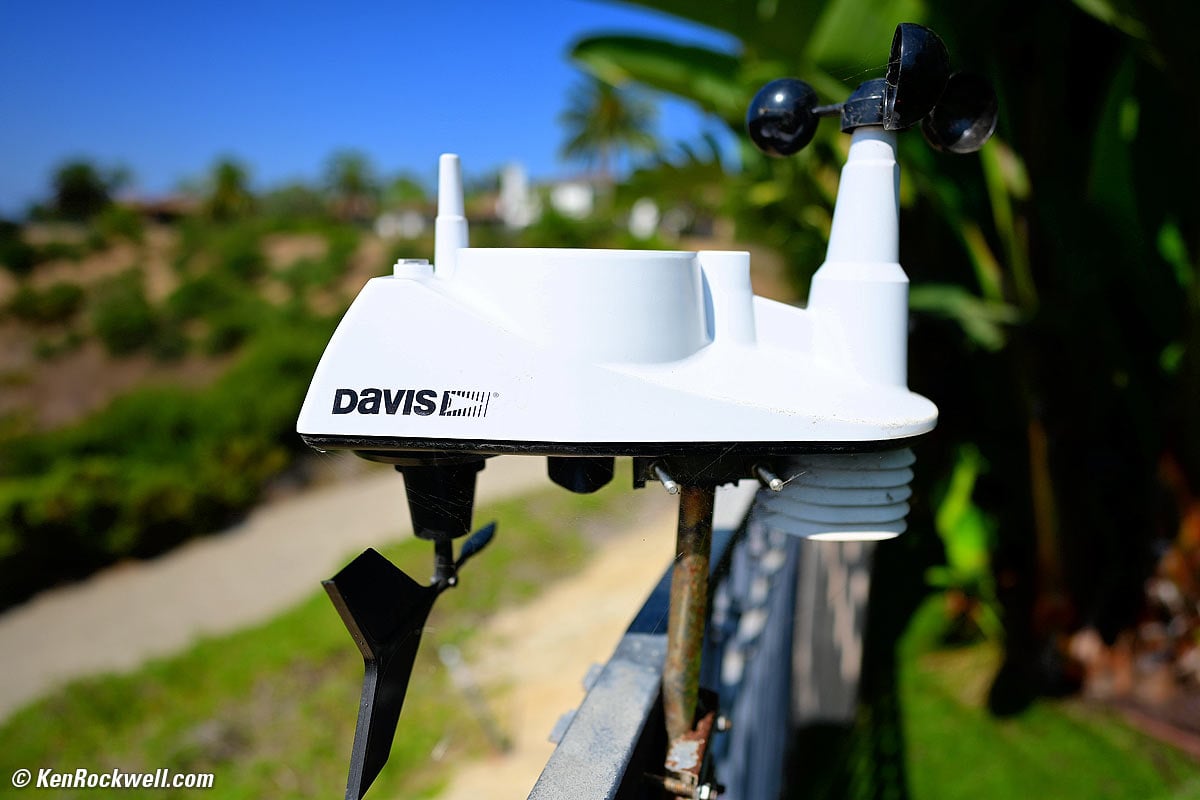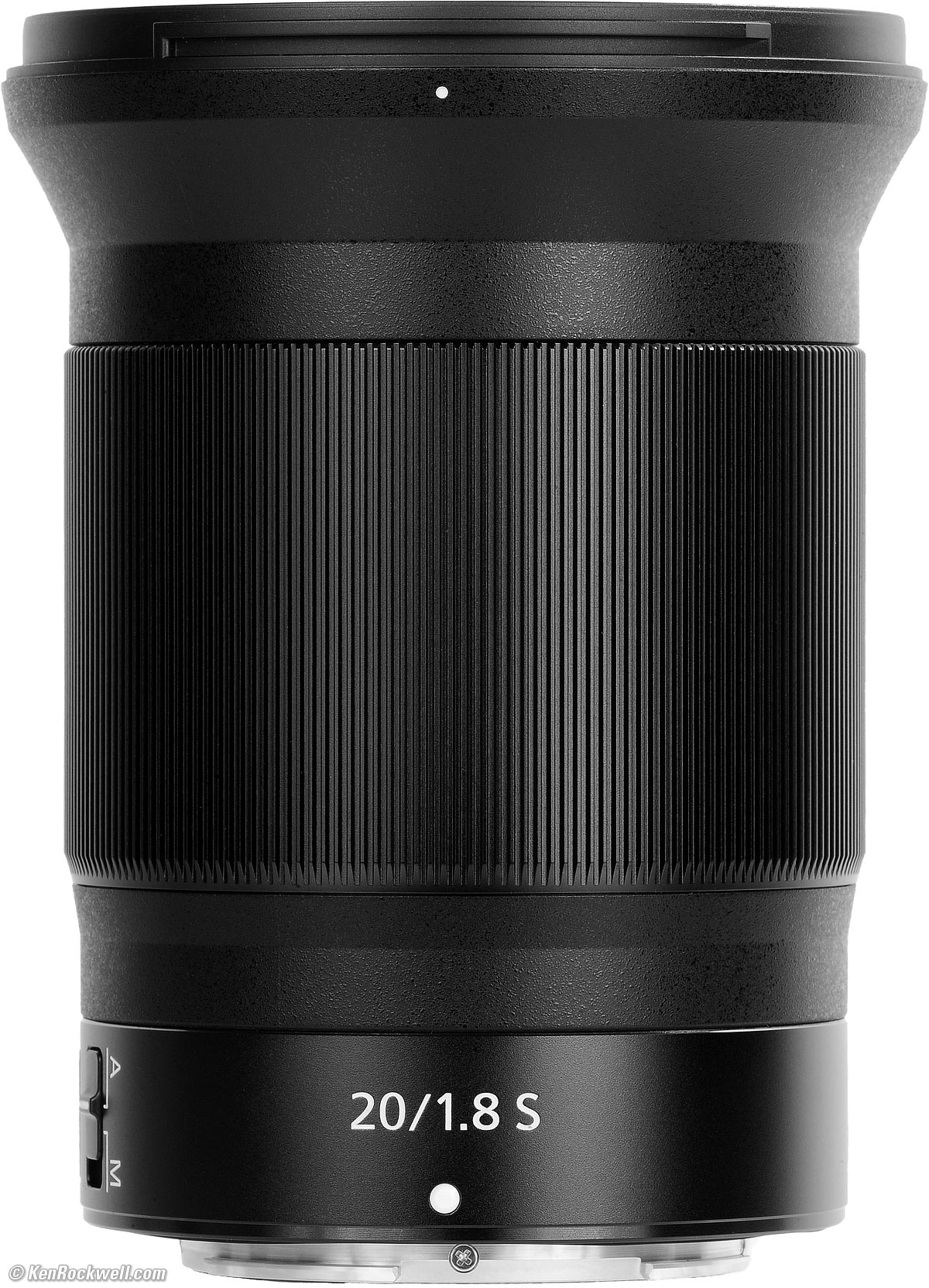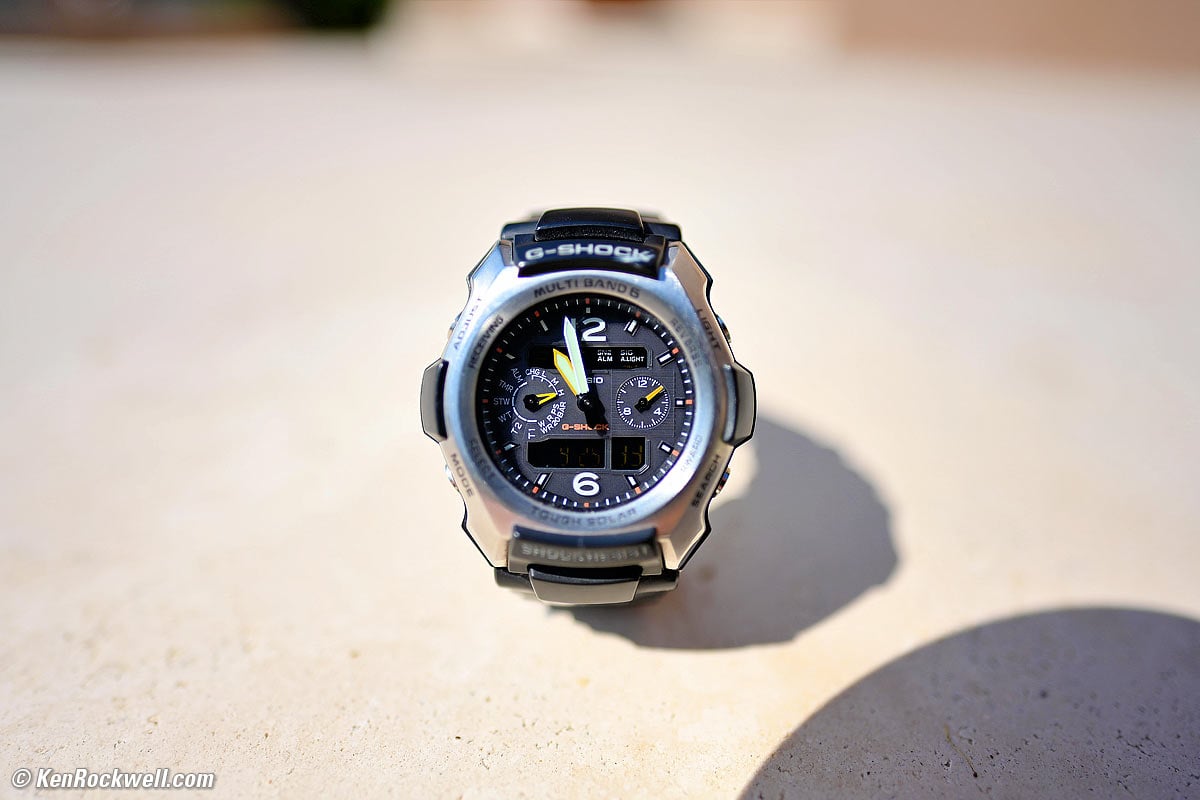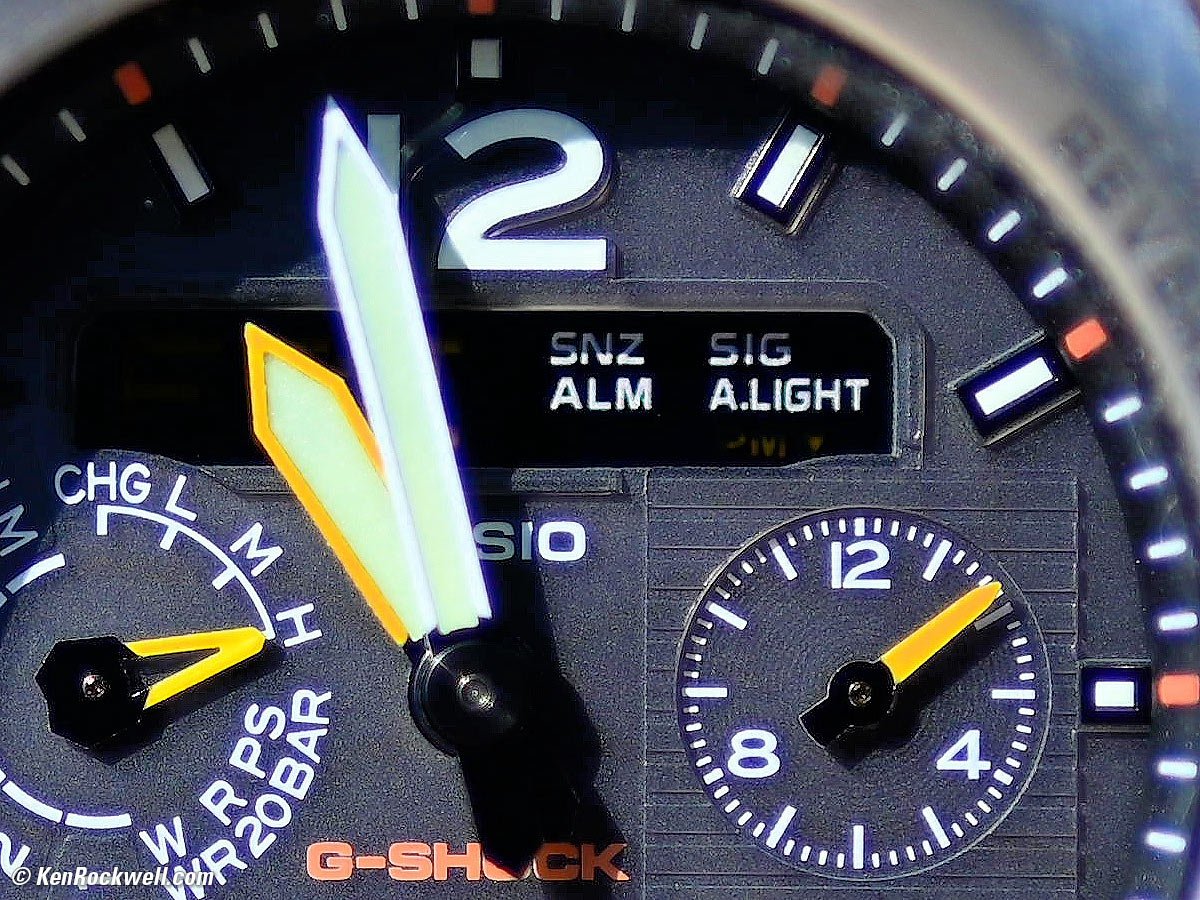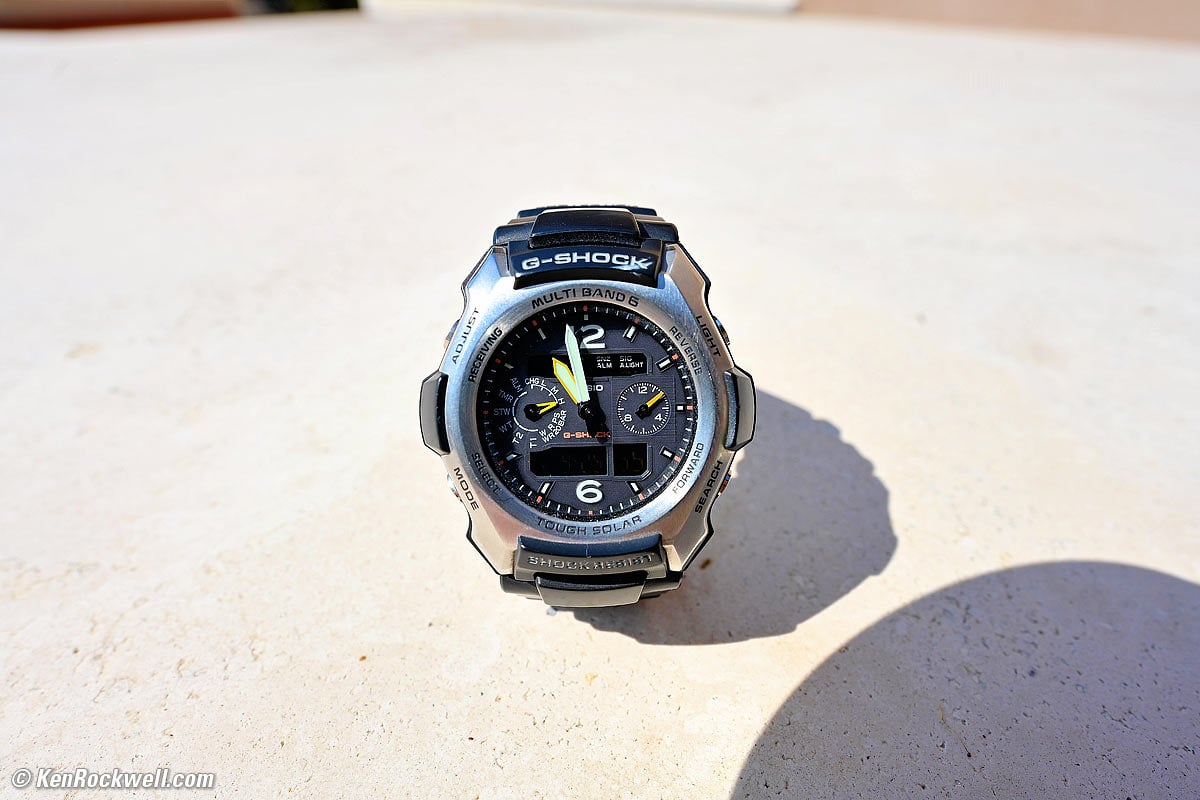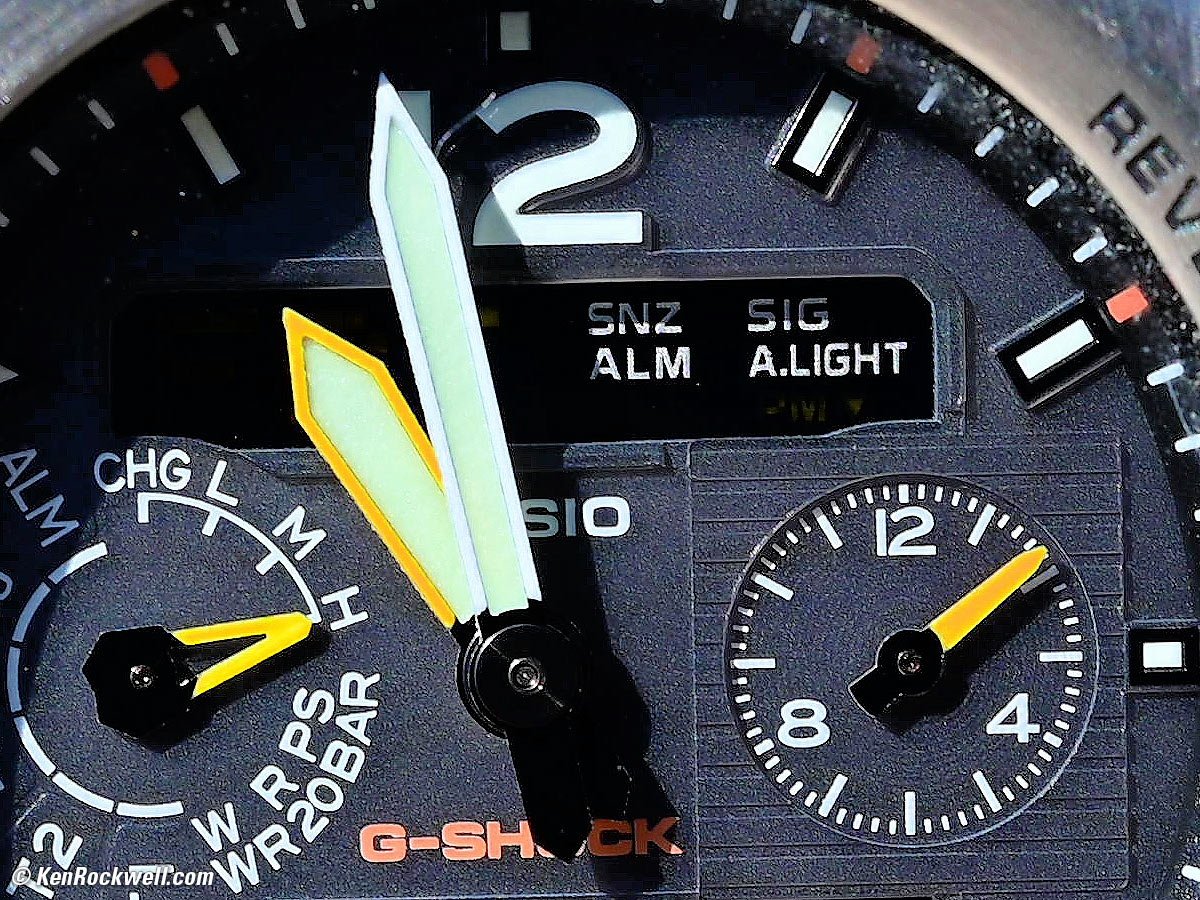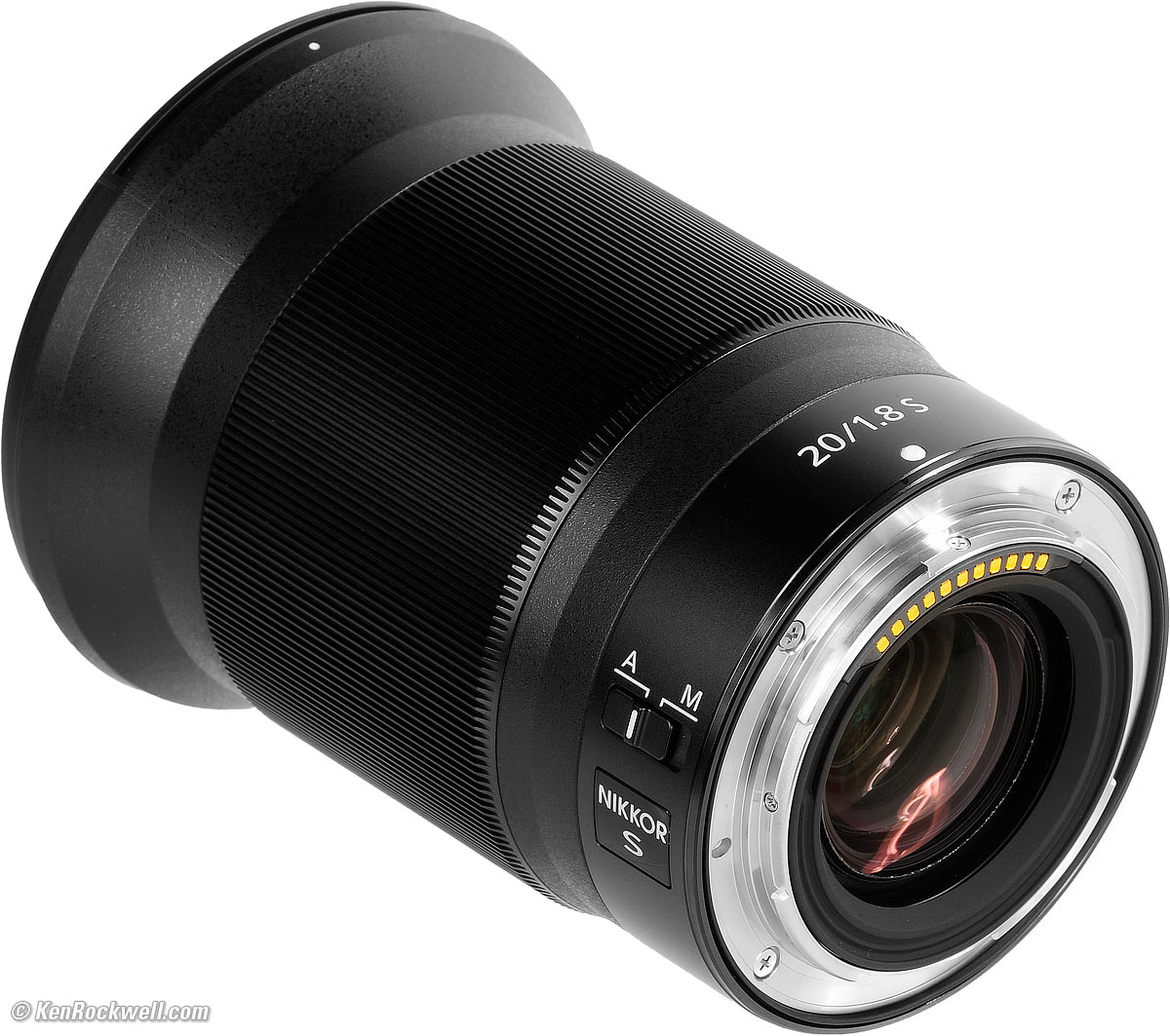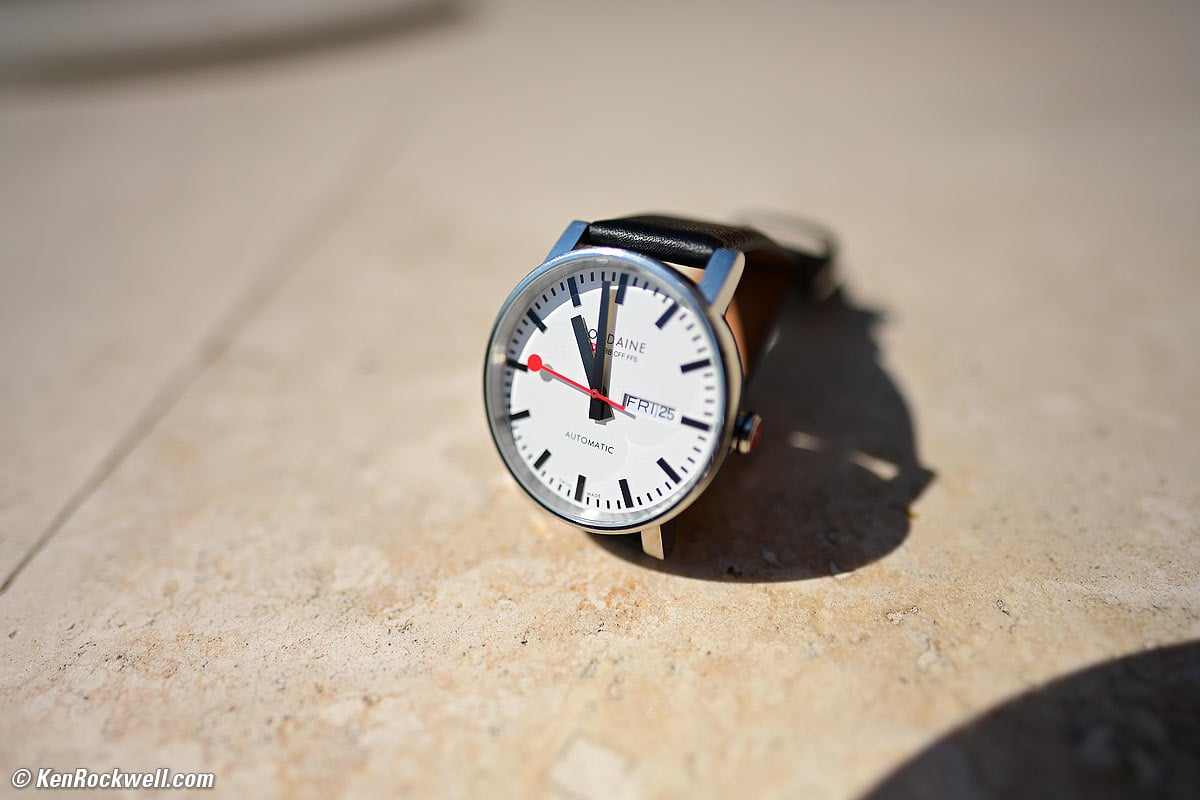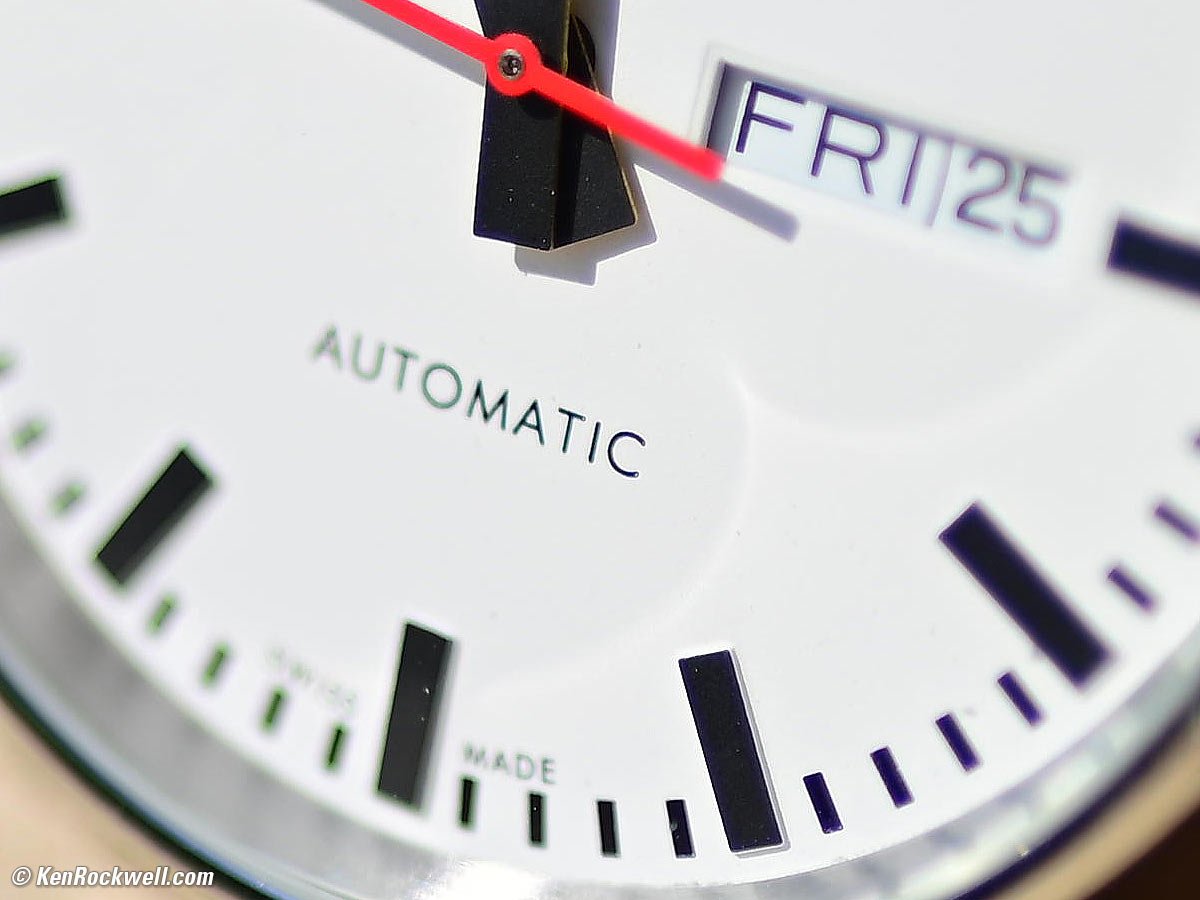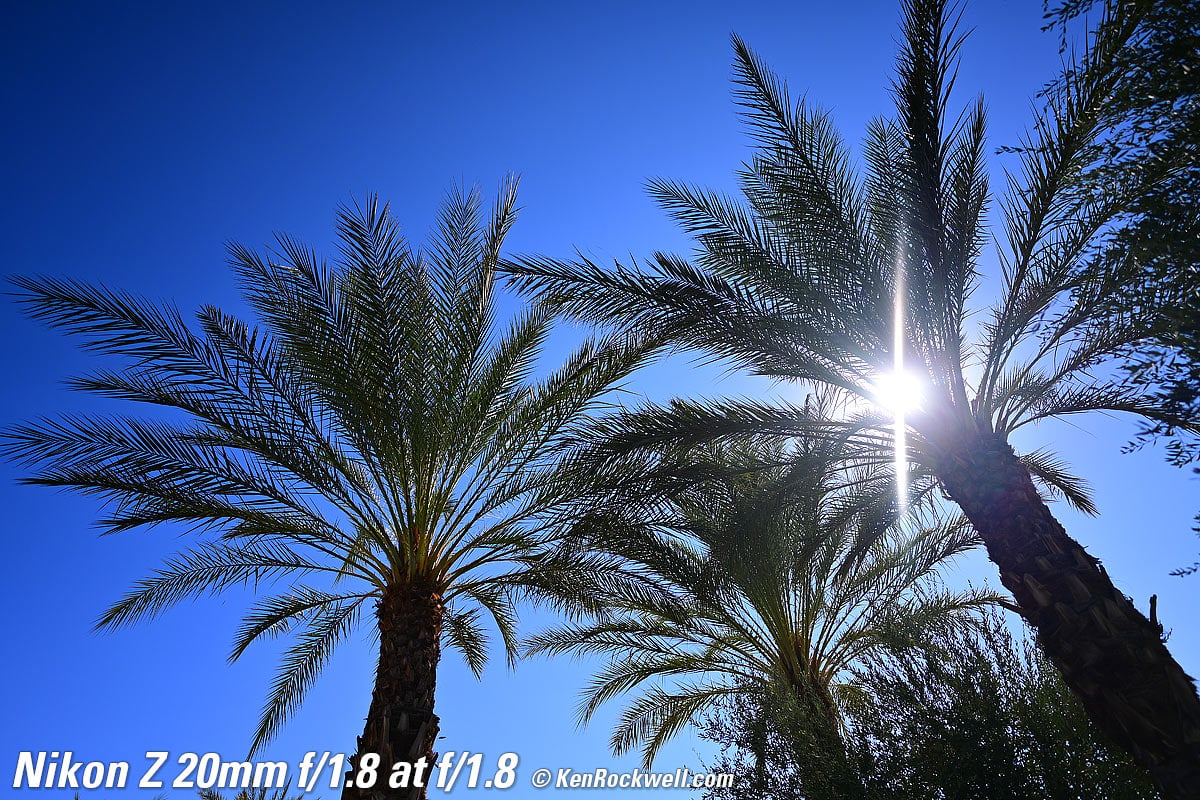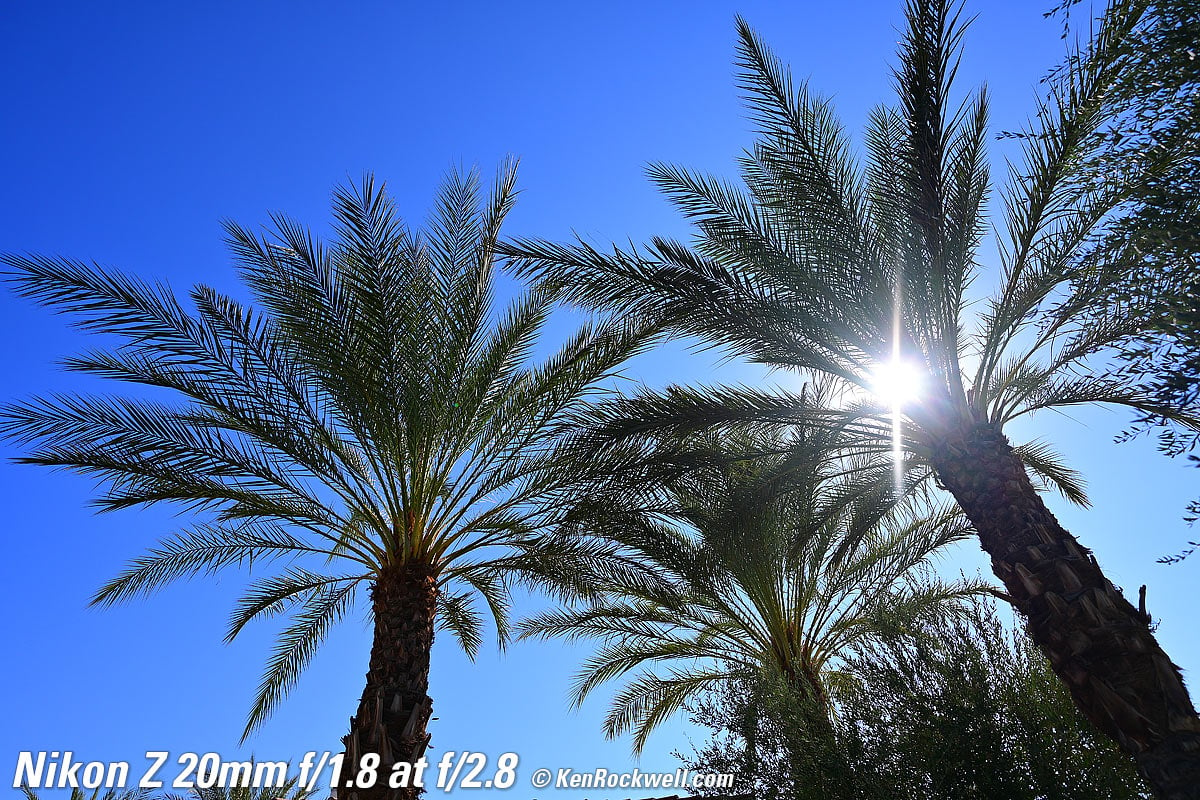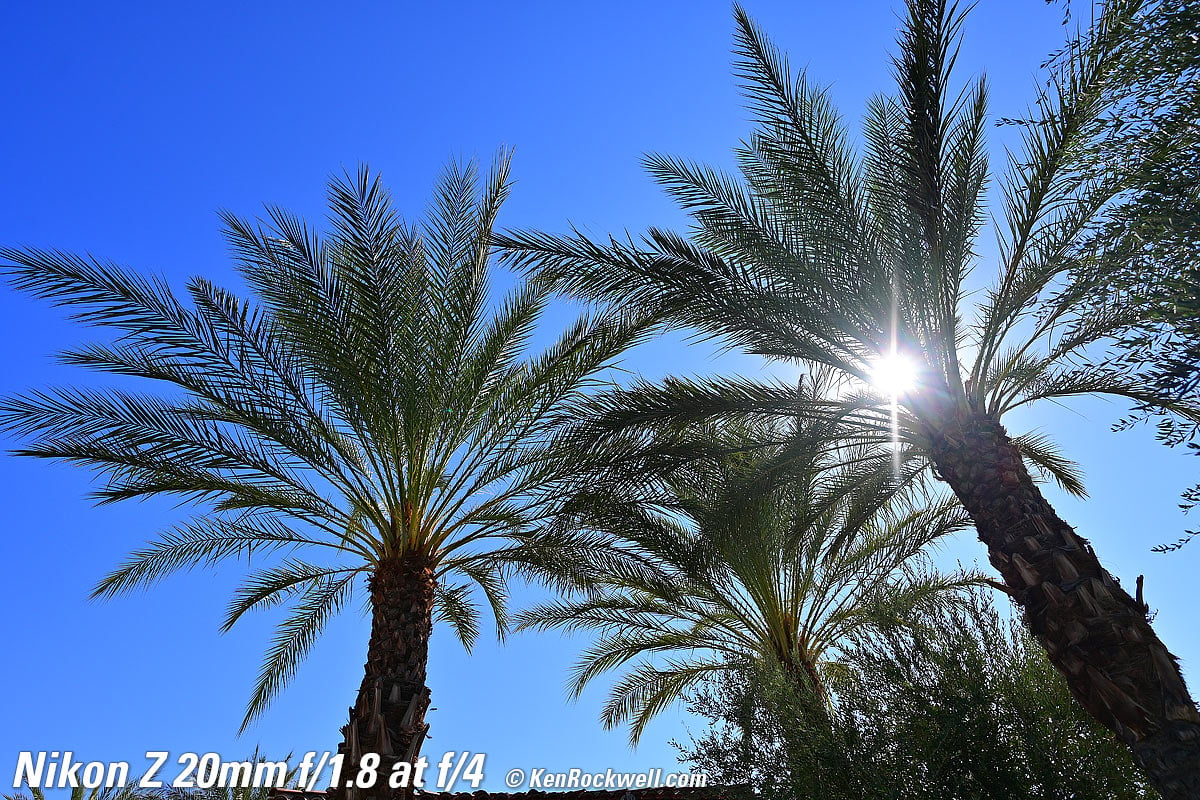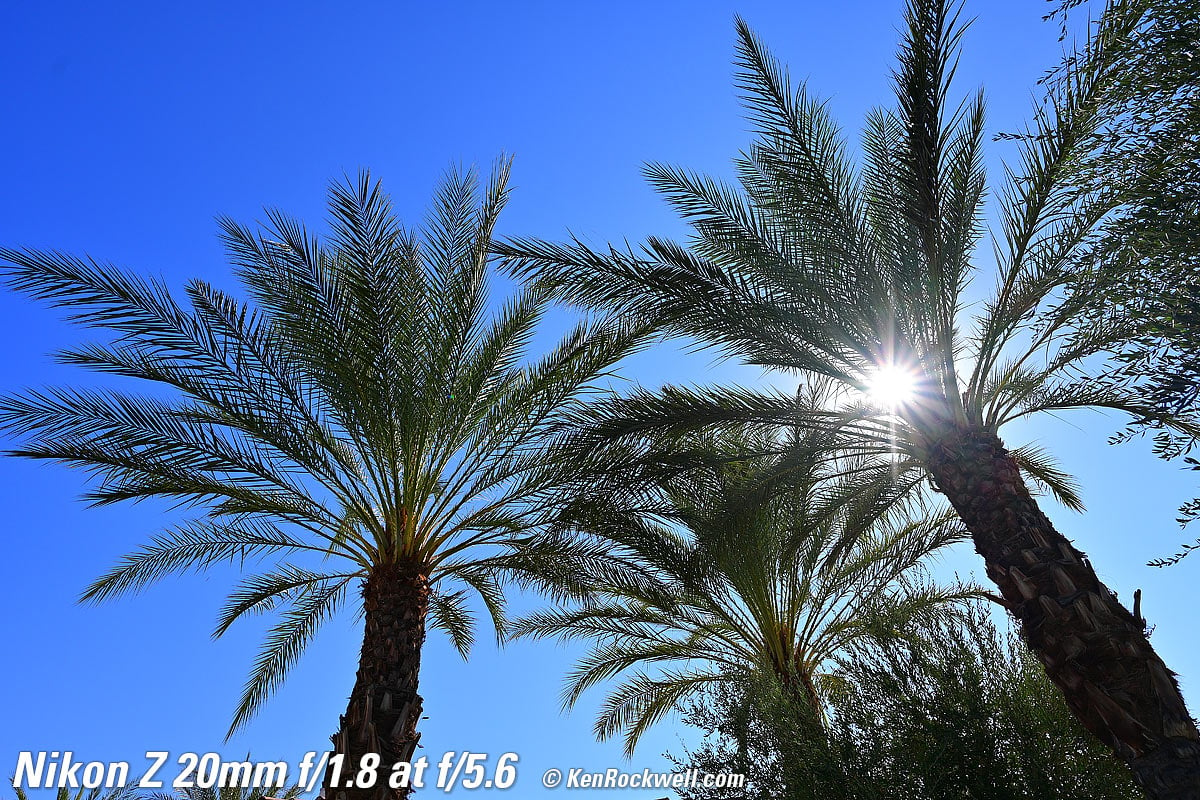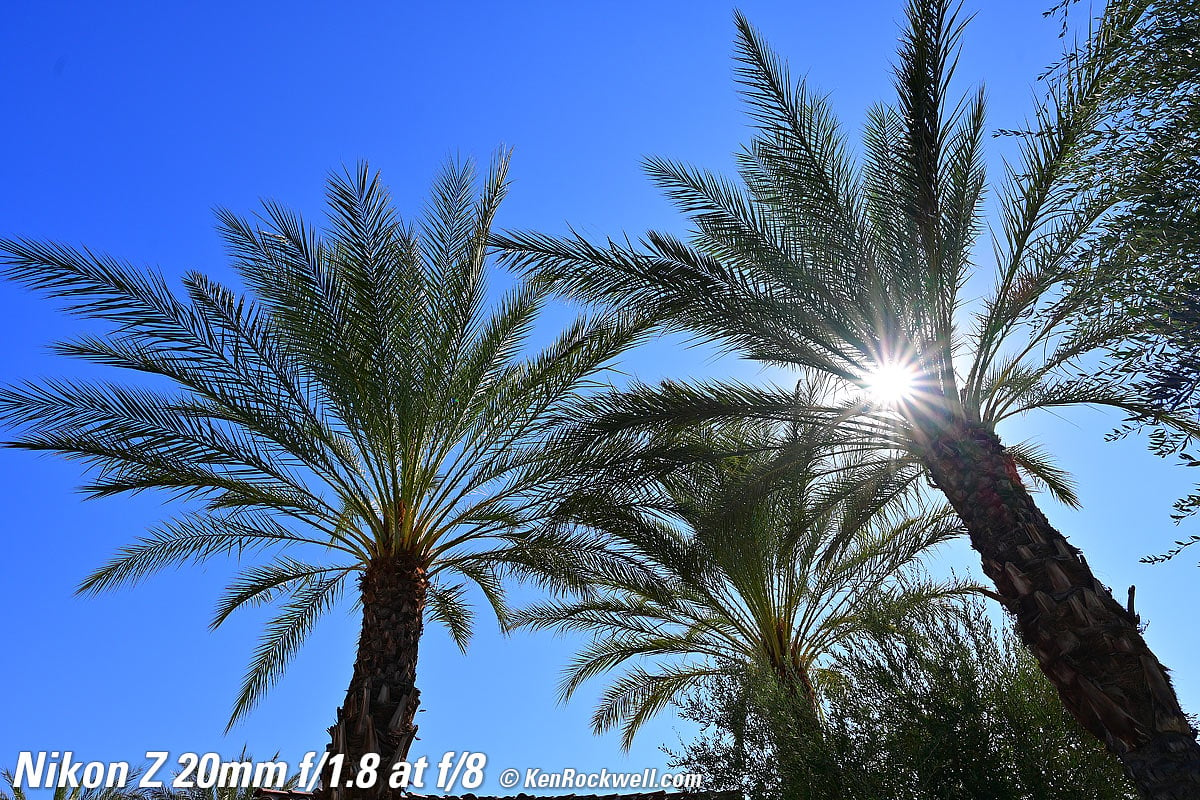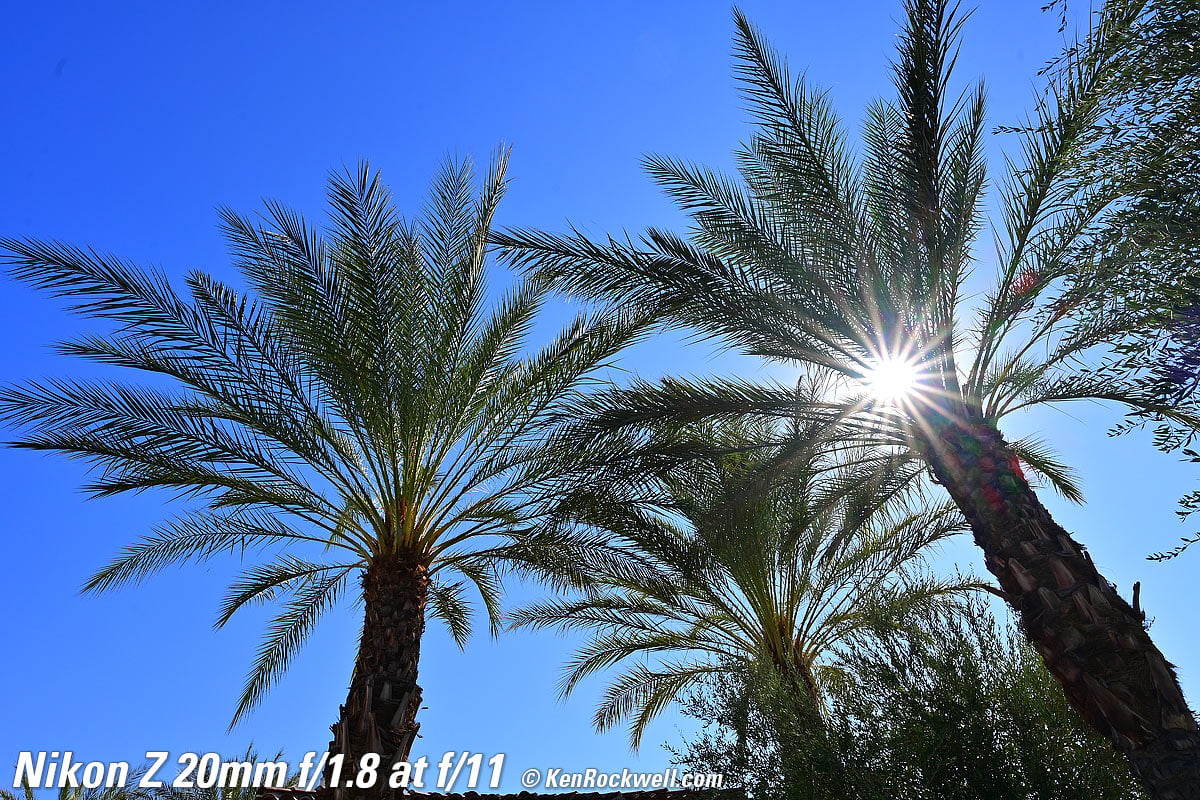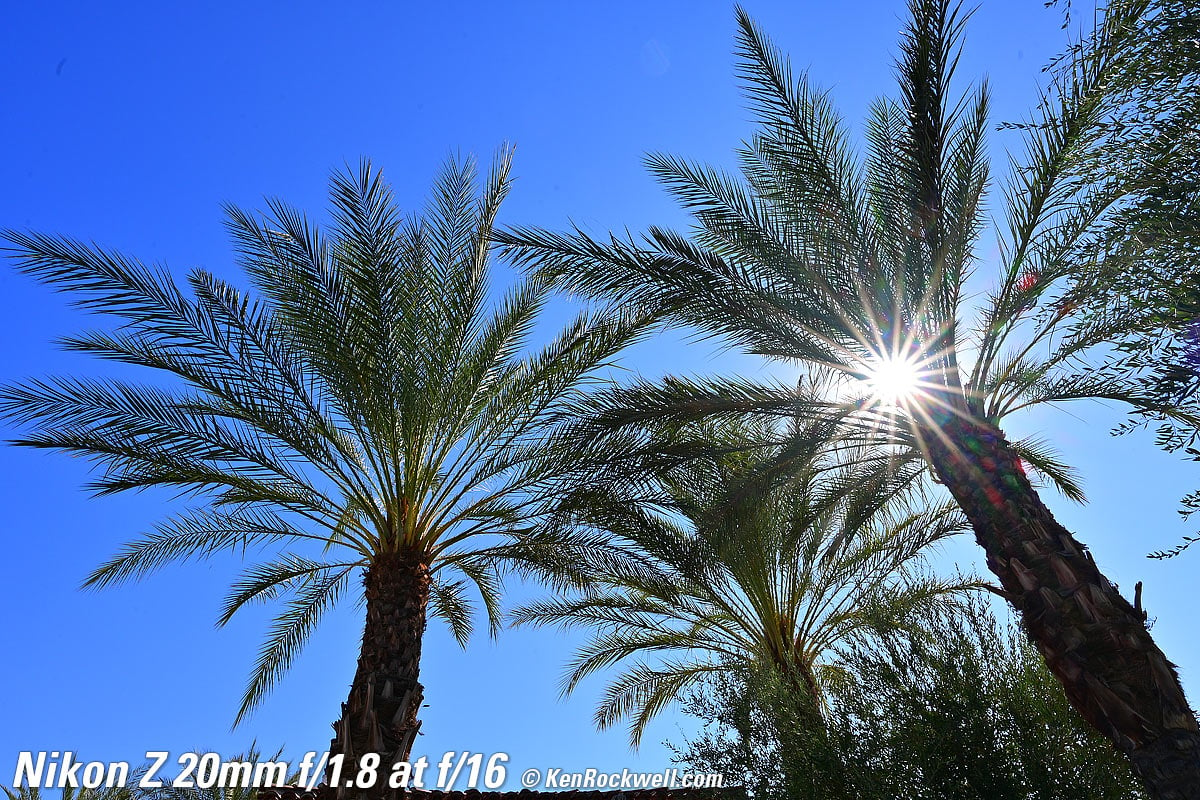Nikon 20mm f/1.8
Full-Frame Z Mirrorless Ultrawide
Compatibility Specifications Legal USA Version
Z9 Z8 Z7 II Z6 II Zf Z7 Z6 Z5 Z fc Z50 Z30
Z System Z Lenses All Nikon Lenses Flash
Nikon NIKKOR Z 20mm f/1.8 S (77mm filters, 17.7 oz./503g, 0.66'/8"/0.2m close focus, $947 new or about $750 used if you know How to Win at eBay). bigger. I got mine at Adorama. I'd also get it at Amazon, at B&H or at Crutchfield, or used at eBay.
This 100% all-content, junk-free website's biggest source of support is when you use those or any of these links to my personally approved sources I've used myself for way over 100 combined years when you get anything, regardless of the country in which you live. Nikon does not seal its boxes in any way, so never buy at retail or any other source not on my personally approved list since you'll have no way of knowing if you're missing accessories, getting a defective, damaged, returned, non-USA, store demo or used lens — and all of my personally approved sources allow for 100% cash-back returns for at least 30 days if you don't love your new lens. I've used many of these stores since the 1970s because I can try it in my own hands and return it if I don't love it, and because they ship from secure remote warehouses where no one gets to touch your new lens before you do. Buy only from the approved sources I've used myself for decades for the best prices, service, return policies and selection.
December 2022 Nikon Mirrorless Mirrorless Lenses All Nikon Lenses Nikon Flash All Reviews
Sony vs. Nikon vs. Canon Full-Frame
Why Fixed Lenses Take Better Pictures
Sample Image top
Compatibility Specifications Legal USA Version
Performance User's Guide Recommendations
More samples at Bokeh, Macro and Spherochromatism.
These are just snapshots; my real work is in my Gallery.
This is shot as a JPG; no RAW files were used or needed.
Seven Palms Oasis, 7:22 PM, 30 September 2020. Nikon Z7, Nikon Z 20mm f/1.8 wide-open at f/1.8 for 25 seconds at ISO 64 (LV -2.3), Perfectly Clear. bigger, full resolution or camera-original © JPG file.
Only some of the palms are in perfect focus at f/1.8. The close stonework and the distant parts are out of focus.
Introduction top
Compatibility Specifications Legal USA Version
|
I buy only from these approved sources. I can't vouch for ads below. |
This Z 20mm f/1.8 is an extremely useful lens for low-light ultrawide action, news, sports and astronomical shooting.
This is a mirrorless version of my great 20mm f/1.8G I've loved so much since it came out in 2014 for my DSLRs.
Neither Canon nor Fujifilm have anything like this. 20mm is the ideal ultrawide focal length, worlds better than 24mm.
A 20/1.8 is one of my favorite lenses. It's ideal for Milky Way, low-light city shots and close-in action and motion in low light.
Just turn the focus ring at any time for instant manual-focus override.
I got my Z 20mm f/1.8 at Adorama. I'd also get it at Amazon, at B&H or at Crutchfield, or used at eBay if you know How to Win at eBay.
New
 Biggest, heaviest and most expensive 20mm lens ever made by Nikon.
Biggest, heaviest and most expensive 20mm lens ever made by Nikon.
 Multi-group internal focussing.
Multi-group internal focussing.
 Nikon's first fixed 20mm lens for its mirrorless Z system.
Nikon's first fixed 20mm lens for its mirrorless Z system.
Good
 Very good optics.
Very good optics.
 Easily takes at least four stacked 77mm filters with no vignetting on full frame.
Easily takes at least four stacked 77mm filters with no vignetting on full frame.
 Fast.
Fast.
 Instant manual-focus override.
Instant manual-focus override.
Bad
 Offshored to China; not made domestically in Japan.
Offshored to China; not made domestically in Japan.
 Big and expensive.
Big and expensive.
Missing
 Only stops down to f/16, not f/22.
Only stops down to f/16, not f/22.
 No Image Stabilization. Even if your camera does this internally it can't stabilize the corners of an ultrawide as well as the center of the image.
No Image Stabilization. Even if your camera does this internally it can't stabilize the corners of an ultrawide as well as the center of the image.
 No aperture ring.
No aperture ring.
 No VR switch to control in-camera stabilization.
No VR switch to control in-camera stabilization.
Nikon NIKKOR Z 20mm f/1.8 S. bigger.
Format top
Compatibility Specifications Legal USA Version
I got my Z 20mm f/1.8 at Adorama. I'd also get it at Amazon, at B&H or at Crutchfield, or used at eBay if you know How to Win at eBay.
This is a full frame FX lens, and I'm reviewing it as such.
It works great on DX mirrorless cameras, on which you may make the usual inferences.
Compatibility top
Compatibility Specifications Legal USA Version
I got my Z 20mm f/1.8 at Adorama. I'd also get it at Amazon, at B&H or at Crutchfield, or used at eBay if you know How to Win at eBay.
This lens works only on Nikon's Z-series mirrorless cameras.
It does not so much as even mount on any other camera.
Specifications top
Compatibility Specifications Legal USA Version
I got my Z 20mm f/1.8 at Adorama. I'd also get it at Amazon, at B&H or at Crutchfield, or used at eBay if you know How to Win at eBay.
Name specifications
Nikon calls this the NIKKOR Z 20mm f/1.8 S:
NIKKOR: Nikon's brand name for all their lenses.
Z: For Nikon's mirrorless cameras.
S: Subliminally suggests sexual satisfaction. The "S" designation has no other purpose than subliminal seduction; Nikon and electronics and automobile and every kind of marketer have been using letters like "S" and "X" in model numbers since the 1940s for this same reason. Nikon called their first 1946 rangefinder lens mount the "S" mount, then went whole-hog to the "F" SLR mount in 1959, used "S" again when they updated their AI lenses to AI-"S" in 1983, created AF-"S" SWM lenses in 1998 and here it is again.
Also has:
AF-P: Stepper (Pulse) autofocus motor: silent for movies.
Aspherical: Specially curved glass elements for sharper pictures.
D: Couples distance information to the 3D Matrix Meter.
E: Electronic diaphragm for silent operation.
ED: Magic Extra-low Dispersion glass for reduced secondary chromatic aberration.
G: Gelded; has no aperture ring.
IF: Internal focusing; nothing moves externally as focused.
Nano Crystal Coat (N): Magic anti-reflection coating that has a variable index of refraction that's far more effective against ghosts and internal reflections than traditional multicoating.
∅77: 77mm filter thread.
Optics specifications top
Nikon Z 20mm f/1.8 internal optical construction. Aspherical and ED elements.
14 elements in 11 groups.
3 ED extra-low dispersion elements, which help reduce secondary axial chromatic aberration.
3 aspherical elements.
Internal multi-group focussing system.
Nikon Super Integrated multicoating (SIC).
Nano Crystal Coating for even fewer ghosts and flare.
Filters specifications top
77 mm filter thread.
Diaphragm specifications top
Nikon NIKKOR Z 20mm f/1.8 S. bigger.
9 rounded blades.
Electronically actuated.
Stops down to f/16.
Focal Length specifications top
20mm.
When used on an APS-C camera, it sees the same angle of view as a 30 mm lens sees when used on a full-frame or 35mm camera.
See also Crop Factor.
Angle of View specifications top
94º diagonal on FX.
70º diagonal on DX.
Autofocus specifications top
Multi-group internal focussing.
No external movement as focussed, so no air or dust is sucked in.
Focus Scale specifications top
Not on lens, but may be displayed in-camera.
Infinity Focus Stop specifications top
No.
Depth of Field Scale specifications top
Not on lens, but may be displayed in-camera.
Infrared Focus Index specifications top
No.
Close Focus specifications top
0.66 feet (8" or 0.2 meters) from the image plane; which means just inches away from the front of the lens!
Maximum Reproduction Ratio specifications top
1:5.3 (0.19 ×).
Reproduction Ratio Scale specifications top
No.
Image Stabilizer specifications top
NONE.
Caps specifications top
LC-77B front cap and LF-N1 Z-mount rear cap, included.
Hood specifications top
HB-95 plastic bayonet hood, included.
"Case" specifications top
Nikon CL-C1 Lens "Case". bigger.
Nikon claims it includes a case, but it's only a CL-C1 cloth bag.
A tube sock works better.
I love my Think Tank Retrospective bags for carrying this lens with my Z system: the Z 24-200mm, this lens and my SB-400 flash.
Size specifications top
3.4" ø maximum diameter × 4.3" extension from flange.
84.5 mm ø maximum diameter × 108.5 mm extension from flange.
Weight specifications top
17.745 oz. (503.0 g) actual measured weight.
Rated 17.9 oz. (505 g).
Announced specifications top
11PM, Tuesday, 11 February 2020, NYC time.
Promised for specifications top
March 2020.
Included specifications top
LC-77B front cap.
LF-N1 Z-mount rear cap.
HB-95 hood.
CL-C1 lens sack.
Nikon's Model Number specifications top
20093.
Price, U. S. A. specifications top
December 2022
$947 at Adorama, at Amazon, at B&H or at Crutchfield.
About $750 used if you know How to Win at eBay.
July 2021
$1,047 at Adorama, at Amazon, at B&H or at Crutchfield.
About $850 used if you know How to Win at eBay.
October 2020
$1,047 at Adorama, at Amazon, at B&H or at Crutchfield.
About $900 used if you know How to Win at eBay.
February ~ September 2020.
$1,047 at Adorama, at Amazon, at B&H or at Crutchfield.
Getting a Legal USA Version top
Compatibility Specifications Legal USA Version
This section applies in the USA only.
I got my Z 20mm f/1.8 at Adorama. I'd also get it at Amazon, at B&H or at Crutchfield, or used at eBay if you know How to Win at eBay.
In the USA, be sure your box contains a card printed "4 YEARS USA EXTENDED SERVICE COVERAGE" and that the serial number on the card matches the one on your lens exactly.
If not, you got ripped off with a gray market version from another country. (The serial number on the box doesn't have to match, but if it doesn't it means you bought from a shady dealer who took lenses out of boxes and then resold them as new.) This is why I never buy anyplace other than from my personally approved sources. You just can't take the chance of buying elsewhere, especially at any retail store, because non-USA versions have no warranty in the USA, and you won't even be able to get firmware or service for it — even if you're willing to pay out-of-pocket for it when you need it!
Nikon USA enforces its trademarks strictly. It's unlikely, but possible that US customs won't let your camera back in the country if you bought a gray-market version in the USA, carried it overseas, and try to bring it back in. (If you take the chance of buying one overseas, be sure you have a receipt to prove you bought it overseas and be prepared to pay duty on it.)
If a gray market version saves you $500 it may be worth it, but for $300 or less I wouldn't risk having no warranty or support.
Always be sure to check your box while you can still return it, or just don't buy from unapproved sources or at retail so you'll be able to have your camera serviced and get free updated firmware as needed.
I got my Z 20mm f/1.8 at Adorama. I'd also get it at Amazon, at B&H or at Crutchfield, or used at eBay if you know How to Win at eBay.
Get yours from the same places I do and you won't have a problem, but if you take the risk of getting yours elsewhere, be sure to check everything while you still can return it. Never buy at retail because the boxes are unsealed and it's an almost certainty that a lens as exotic and desirable as this will have been taken out on a few weekend "test shoots" by the salesmen before being sold to you. Never buy retail, unless you want to pay full price for a lens dropped - and returned - by others.
Performance top
Compatibility Specifications Legal USA Version
Overall Autofocus Manual Focus Breathing
Bokeh Distortion Ergonomics Falloff
Filters Flare & Ghosts Lateral Color Fringes
Lens Corrections Macro Mechanics
I got my Z 20mm f/1.8 at Adorama. I'd also get it at Amazon, at B&H or at Crutchfield, or used at eBay if you know How to Win at eBay.
Overall performance top
The Z 20/1.8 is a fast f/1.8 for astronomy and low-light action, but also the biggest, heaviest and most expensive 20mm lens ever made by Nikon.
Autofocus performance top
Autofocus speed is only moderate, but this is also a factor of my Nikon Z7, which wins no prizes for autofocus.
Manual Focus performance top
Manual focus is great; just grab the big focus ring at any time.
Manual focusing is entirely electronic; the manual focus ring isn't connected to anything other than a digital encoder.
Focus Breathing performance top
Focus breathing is the image changing size as focused in and out. It's important to cinematographers that the image not breathe because it looks funny if the image changes size as focus gets pulled back and forth between actors. If the lens does this, the image "breathes" by growing and contracting slightly as the dialog goes back and forth.
The image from this Z 20 1.8 shrinks as focussed more closely.
Bokeh performance top
Bokeh, the feel, character or quality of out-of-focus areas as opposed to how far out of focus they are, isn't very important because things never get that far out of focus with ultrawide lenses like this. If you look hard enough, the bokeh is neutral: blur circles are just circles.
Here's a shot from headshot distance wide-open:
Made-in-U. S. A. Davis 6250 weather station, 25 September 2020. Nikon Z7, Nikon Z 20mm f/1.8 wide-open at f/1.8 at 1/4,000 at ISO 64 with +0.7 stops exposure compensation (LV 14.3). bigger or camera-original © file.
As always, if you want to throw the background as far out of focus as possible, shoot at f/1.8 and get as close as you can.
Distortion performance top
The Nikon Z 20mm f/1.8 has only minor barrel distortion that probably won't be visible as shot on Nikon's Z cameras, even after their automatic correction. No, I have no idea why my Z7 doesn't correct it fully.
Sadly, one still needs to use a correction factor of +1.00 in Photoshop's lens correction filter for JPG images shot with Distortion correction ON for critical scientific use. For normal use, you won't see it.
If you go out of your way to turn off the automatic correction and go looking for it, you'll need a correction factor of +4.00 in Photoshop's lens correction filter for JPG images.
Beware: if you shoot raw and then open these files with non-Nikon software, it's very likely that you will have no distortion correction and will see distortion. I haven't tried; I don't shoot raw.
Ergonomics performance top
Nikon NIKKOR Z 20mm f/1.8 S. bigger. |
Nikon NIKKOR Z 20mm f/1.8 S. bigger. |
There are no secrets here; half the lens is the big metal focus ring and there's but one AF/MF slide switch, and that's it.
By default the focus ring is always active for instant override. It's entirely electronic; it's not connected to anything mechanically.
You can program the ring to other things than focus if you prefer.
Falloff performance top
Falloff on full-frame is invisible, although if you look hard you might see a little bit wide-open at f/1.8.
I've greatly exaggerated the falloff by shooting a gray field and placing these on a gray background; it will not look this bad in actual photos of real things:
Z 20/1.8 falloff on full-frame at infinity, Vignette control NORMAL.
© 2020 KenRockwell.com. All rights reserved. |
Of course if you're silly enough to turn off Vignette control and then go looking for it, you'll see a bit more:
Z 20/1.8 falloff on full-frame at infinity, Vignette control OFF.
© 2020 KenRockwell.com. All rights reserved. |
Filters, use with performance top
There's no need for thin filters. I can stack at least four regular 77mm filters without vignetting at any distance or aperture. I say "at least" because I only had four filters handy when I tried this; I might be able to use more.
This is excellent.
Go ahead and use your standard rotating polarizer and grad filters.
Don't use polarizers on ultrawide lenses; the sky's natural polarization will appear as a dark band in the sky.
Flare & Ghosts performance top
There aren't any ghosts or flare worth worrying about.
See examples at Sunstars.
Lateral Color Fringes performance top
Nikon Z cameras all correct for this automatically, and this correction can't be turned off, so there are no fringes shot as JPG.
If you shoot raw and then create images from this raw data using other than Nikon software, it's entirely probable that your particular software won't correct for this, and you could then see color fringes.
There is spherochromatism, which is a completely different aberration in a different dimension than lateral color. In English, this means that there can be color fringes at large apertures in sections of the image that aren't in perfect focus, and with a little bit of field curvature you could be seeing some bluish fringes in the corners at f/1.8 if the field of best focus has pushed itself out past infinity.
Lens Corrections performance top
Nikon's Z cameras always correct for lateral color fringes (chromatic aberration). This has been part of Nikon's secret sauce since 2007 and never appears in any menu.
Other cameras may be slightly different, but the Z6 and Z7 correct for distortion, diffraction and falloff.
Distortion, diffraction and falloff correction are all ON by default.
You may turn diffraction and distortion correction ON or OFF.
You may set falloff ("Vignette control") correction to OFF, LOW, NORMAL (default), or HIGH.
Macro Performance performance top
Close focus gets really close; so close that it's hard not to block the light! Here's how close you can get on full frame. The shadow in the lower right is the lens, and I had to work a while to find an alignment that got light on the watch without casting a shadow on the watch:
At f/1.8
Casio G-Shock Solar Atomic Watch at close-focus distance at f/1.8, 25 September 2020. Z7 at 1/4,000 at ISO 64. bigger or camera-original © file.
It's super sharp, but spherochromatism is putting color fringes on anything even slightly out of focus, which at this distance is just about everything:
1,200 × 900 pixel (6.8× magnification) crop from above. bigger or camera-original © file.
If this 1,200 × 900 pixel crop is about 3" (7.5cm) wide on your screen, the complete image would print at a large 14 × 21″ (35 × 55 cm) at this same high magnification.
If this 1,200 × 900 pixel crop is about 6" (15cm) wide on your screen, the complete image would print at a huge 27½ × 41¼″ (70 × 105 cm) at this same high magnification.
If this 1,200 × 900 pixel crop is about 12" (30cm) wide on your screen, the complete image would print at a mammoth 55 × 82½″ (1.4 × 2.1 meters) at this same extremely high magnification!
At f/8
Casio G-Shock Solar Atomic Watch at close-focus distance at f/8, 25 September 2020. Z7 at 1/200 at ISO 64. bigger or camera-original © file.
It's super sharp at f/8, which also eliminates the spherochromatism we saw at f/1.8:
1,200 × 900 pixel (6.8× magnification) crop from above. bigger or camera-original © file.
If this 1,200 × 900 pixel crop is about 3" (7.5cm) wide on your screen, the complete image would print at a large 14 × 21″ (35 × 55 cm) at this same high magnification.
If this 1,200 × 900 pixel crop is about 6" (15cm) wide on your screen, the complete image would print at a huge 27½ × 41¼″ (70 × 105 cm) at this same high magnification.
If this 1,200 × 900 pixel crop is about 12" (30cm) wide on your screen, the complete image would print at a mammoth 55 × 82½″ (1.4 × 2.1 meters) at this same extremely high magnification!
Mechanical Quality performance top
Nikon NIKKOR Z 20mm f/1.8 S. bigger.
Let's not kid ourselves: this is an almost all-plastic Chinese-made lens with glass glass, a metal mount and a few trim pieces made of metal to throw off the innocent. It combines the benefits (for Nikon) of a pro-level-price with offshored consumer construction quality. This is not an heirloom-quality lens as Nikon's manual-focus lenses are.
Finish
Black plastic.
Hood
Plastic bayonet.
Front Bumper
None.
Filter Threads
Plastic.
Hood Bayonet Mount
Plastic.
Front Barrel Exterior
Plastic.
Metal.
Focus Ring
Thin metal.
Slide Switch
Plastic.
Rear Barrel Exterior
Plastic, with metal trim around the very back section.
Identity
Engraved around front of lens, also engraved on top of barrel.
Internals
Seem like all plastic.
Dust Gasket at Mount
Yes.
Mount
Chromed metal.
Serial Number
Laser engraved on bottom of barrel.
Date Code
None found.
Noises When Shaken
Mild clicking.
Made in
Made in China.
Sharpness performance top
Lens sharpness has nothing to do with picture sharpness; every lens made in the past 100 years is more than sharp enough to make super-sharp pictures if you know what you're doing. The only limitation to picture sharpness is your skill as a photographer. It's the least talented who spend the most time worrying about lens sharpness and blame crummy pictures on their equipment rather than themselves. Skilled photographers make great images with whatever camera is in their hands; I've made some of my best images of all time with an irreparably broken camera! Most pixels are thrown away before you see them, but camera makers don't want you to know that.
If you're not getting ultra-sharp pictures with this, be sure not to shoot at f/11 or smaller where all lenses are softer due to diffraction, always shoot at ISO 100 or below because cameras become softer at ISO 200 and above, be sure everything is in perfect focus, set your camera's sharpening as you want it (I set mine to the maximum) and be sure nothing is moving, either camera or subject. If you want to ensure a soft image with any lens, shoot at f/16 or smaller at ISO 1,600 or above at default sharpening in daylight of subjects at differing distances in the same image.
As you saw at the top, it's super-sharp even wide-open at f/1.8. In actual practice you have to be careful to be sure the corners are in perfect focus if you want them sharp, too. It seems like there could be some field curvature which pushes the plane of best focus out a bit at the far corners on full frame. Look at the full-resolution image.
Of course the corners get sharper stopped down.
Nikon's MTF chart at 10 cyc/mm and 30 cyc/mm.
Spherochromatism performance top
Spherochromatism, also called secondary spherical chromatic aberration or "color bokeh," is an advanced form of spherical and chromatic aberration in a different dimension than lateral chromatic aberration. It happens mostly in fast normal and tele lenses when spherical aberration at the ends of the color spectrum are corrected differently than in the middle of the spectrum. Spherochromatism can cause colored fringes on out-of-focus highlights, usually seen as green fringes on backgrounds and magenta fringes on foregrounds. Spherochromatism is common in fast lenses of moderate focal length when shooting contrasty items at full aperture. It goes away as stopped down.
Oddly for such a wide lens it has fairly strong spherochromatism, but good for us there's so infrequently anything out of focus with such a wide lens I never saw it except in this torture test:
Mondaine A132.30348.11SBB at close-focus distance at f/1.8, 25 September 2020. Z7 at 1/8,000 at ISO 64. bigger or camera-original © file.
1,200 × 900 pixel (6.8× magnification) crop from above. bigger or camera-original © file.
If this 1,200 × 900 pixel crop is about 3" (7.5cm) wide on your screen, the complete image would print at a large 14 × 21″ (35 × 55 cm) at this same high magnification.
If this 1,200 × 900 pixel crop is about 6" (15cm) wide on your screen, the complete image would print at a huge 27½ × 41¼″ (70 × 105 cm) at this same high magnification.
If this 1,200 × 900 pixel crop is about 12" (30cm) wide on your screen, the complete image would print at a mammoth 55 × 82½″ (1.4 × 2.1 meters) at this same extremely high magnification!
Image Stabilization performance top
This lens has NO Optical Image Stabilization (OIS), IS or VR (Vibration Reduction) — but some of Nikon's cameras have built-in stabilization.
"Percent Perfectly Sharp Shots" are the percentage of frames with 100% perfect tripod-equivalent sharpness I get when I'm shooting hand-held while free-standing with no support or bracing. Hand tremor is a random occurrence, so at marginal speeds some frames will be perfectly sharp while others will be in various stages of blur — all at the same shutter speed. This rates what percentage of shots are perfectly sharp, not how sharp are all the frames:
| % Perfectly Sharp Shots, center of image, Z7 with firmware 3.11 | 1 |
1/2 |
1/4 |
1/8 |
1/15 |
1/30 |
1/60 |
1/125 |
1/250 |
| Stabilization ON | 0 |
0 |
100 |
100 |
100 |
100 |
100 |
100 |
100 |
| Stabilization OFF | 0 |
0 |
0 |
5 |
40 |
83 |
100 |
100 |
100 |
In the center of the image as tested here, I see a three-stop real-world improvement. That's great, but beware:
BEWARE: Sensor-shift stabilization can work great with normal lenses and in the very center of ultra-wide lenses, however it cannot stabilize the corners of ultrawides because the projection of these lenses would require the sensor to more in the corners than in the center. With a 20mm lens, the corners would have to move 47% more (1/cosine(94º angle of view/2)) than the center, which clearly isn't going to happen unless you have a rubber sensor.
In English, this means while I get three real stops of improvement in the center, the correction becomes less effective as you approach the corners. I documented this with Sony's unstabilized 12-24mm f/2.8: while the center stays sharp, the corners may suffer from camera shake.
Sunstars performance top
With a 9-bladed rounded diaphragm, I get pretty good 18-pointed sunstars on brilliant points of light at the smaller apertures.
Ignore the the vertical smear at large apertures, this is is a sensor artifact called interline transfer smear; it's not a lens defect.
Likewise ignore the crazy rainbow effects at small apertures; these are different sensor artifacts caused by taking a picture directly of the sun and exposing for the dark underside of the palm tree.
Click any to enlarge:
Click any to enlarge.
User's Guide top
Compatibility Specifications Legal USA Version
I got my Z 20mm f/1.8 at Adorama. I'd also get it at Amazon, at B&H or at Crutchfield, or used at eBay if you know How to Win at eBay.
Nikon Z 20mm f/1.8. bigger.
A - M Switch
A: Auto Focus. You have instant manual focus override by turning the focus ring at any time. It will try to ignore minor accidental bumps.
M: Manual Focus only.
VR Switch
Nikon deleted the VR switch to control in-camera stabilization.
To set this you now have to go into your camera's menu system.
I put this item in my My Menu menu.
Recommendations top
Compatibility Specifications Legal USA Version
I got my Z 20mm f/1.8 at Adorama. I'd also get it at Amazon, at B&H or at Crutchfield, or used at eBay if you know How to Win at eBay.
I love 20mm lenses. I love fast 20mm lenses, and this is a great choice for Nikon Z for low light. This is a Milky Way and low-light action star!
If you don't need to shoot at f/1.8, then the Z 14-30mm f/4 is a more useful lens because it zooms both wider and closer.
If you shoot both DLSR and mirrorless Z systems you might prefer the 20mm f/1.8G because it can work on both systems. I love my AF-S 20mm f/1.8G for my SLR and DSLR systems. I can use my 20mm f/1.8G on my Z system with the FTZ adapter as well. If you don't shoot SLRs or DSLRs then get this Z lens, but if you already own the AF-S 20mm f/1.8G I'd suggest trying the FTZ adapter first.
I use a clear (UV) protective filter instead of a cap so I'm always ready to shoot instantly. I only use a cap when I throw this in a bag with other gear without padding — which is never. The UV filter never gets in the way, and never gets lost, either.
The best protective filter is the 77mm Hoya multicoated HD3 UV which uses hardened glass and repels dirt and fingerprints.
For less money, the B+W 77mm 010 is an excellent filter, as is the multicoated version and the basic multicoated Hoya filters or the 77mm Nikon Clear (NC - UV), but the Hoya HD3 is the toughest and the best.
All these filters are just as sharp and take the same pictures, the difference is how much abuse they'll take and stay clean and stay in one piece.
I got my Z 20mm f/1.8 at Adorama. I'd also get it at Amazon, at B&H or at Crutchfield, or used at eBay if you know How to Win at eBay.
This 100% all-content, junk-free website's biggest source of support is when you use those or any of these links to my personally approved sources I've used myself for way over 100 combined years when you get anything, regardless of the country in which you live. Nikon does not seal its boxes in any way, so never buy at retail or any other source not on my personally approved list since you'll have no way of knowing if you're missing accessories, getting a defective, damaged, returned, non-USA, store demo or used lens — and all of my personally approved sources allow for 100% cash-back returns for at least 30 days if you don't love your new lens. I've used many of these stores since the 1970s because I can try it in my own hands and return it if I don't love it, and because they ship from secure remote warehouses where no one gets to touch your new lens before you do. Buy only from the approved sources I've used myself for decades for the best prices, service, return policies and selection.
Thanks for helping me help you!
Ken, Mrs. Rockwell, Ryan and Katie.
© Ken Rockwell. All rights reserved. Tous droits réservés. Alle Rechte vorbehalten.
Help Me Help You
I support my growing family through this website, as crazy as it might seem.
The biggest help is when you use any of these links when you get anything. It costs you nothing, and is this site's, and thus my family's, biggest source of support. These places always have the best prices and service, which is why I've used them since before this website existed. I recommend them all personally.
If you find this page as helpful as a book you might have had to buy or a workshop you may have had to take, feel free to help me continue helping everyone.
If you've gotten your gear through one of my links or helped otherwise, you're family. It's great people like you who allow me to keep adding to this site full-time. Thanks!
If you haven't helped yet, please do, and consider helping me with a gift of $5.00.
As this page is copyrighted and formally registered, it is unlawful to make copies, especially in the form of printouts for personal use. If you wish to make a printout for personal use, you are granted one-time permission only if you PayPal me $5.00 per printout or part thereof. Thank you!
Thanks for reading!
Mr. & Mrs. Ken Rockwell, Ryan and Katie.
